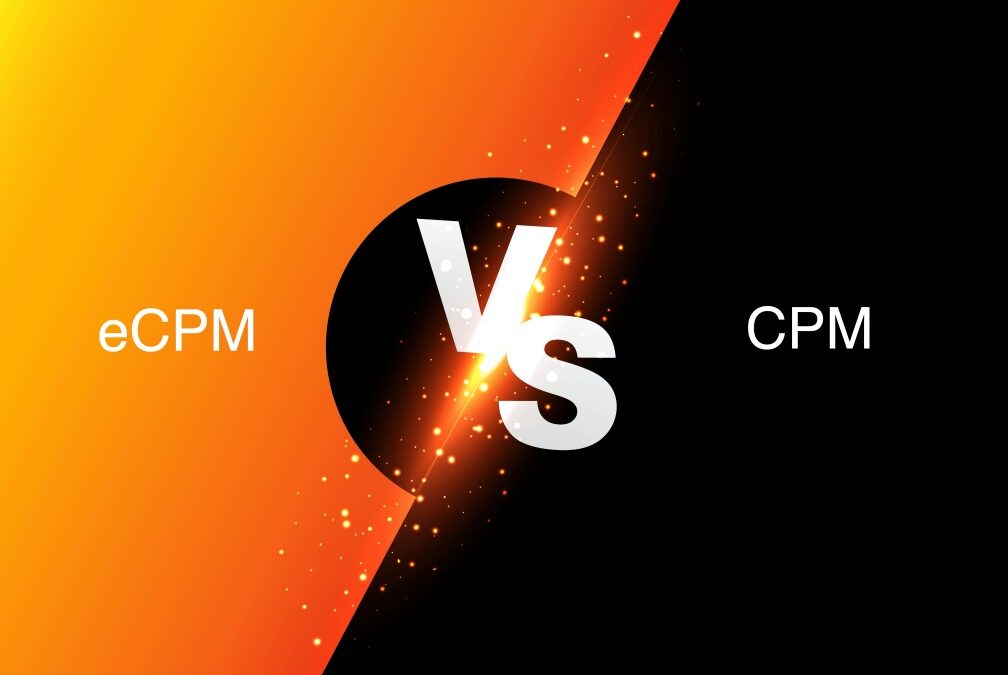It’s no surprise that the field of digital marketing has grown rapidly over the past few years. As more businesses move their operations online, it is becoming increasingly important to understand all the different metrics and terms associated with digital marketing to make informed decisions about how best to advertise your products or services.
Two common metrics that digital marketers use are the CPM (cost per mille) and eCPM (effective cost per mille). This guide will explain the differences between these two metrics and how they are used. We will examine what each metric measures and how they are calculated and provide real-world examples of both in action. By the end of this guide, you will better understand how CPM and eCPM are used in digital marketing and how they can help you make smarter decisions when advertising your business.
What is CPM?
CPM stands for Cost Per Mille (or “thousand”) and is a metric used to measure the cost of advertising campaigns. It represents an advertiser’s price for every thousand impressions (when someone views or interacts with an advertisement). CPM is one of the most commonly used metrics in digital marketing as it helps to compare costs across different campaigns, ad formats, or channels.
To calculate CPM, you simply divide the total cost of a campaign by the number of impressions generated. For example, if an advertiser spent $100 on a campaign that cost per thousand impressions and resulted in 10,000 impressions, then the CPM would be $10 ($100/10,000 = $10). Also, CPM can be used to compare the cost efficiency of different campaigns or channels. For instance, if a campaign generated 10,000 impressions with a CPM of $10 but another generated 20,000 impressions with a CPM of $15, the first campaign would be more cost-efficient.
Why is CPM Important for Publishers?
CPM is important for publishers as it determines the ad revenue they can earn from their campaigns. The higher the CPM, the more money a publisher can make from every thousand impressions of their advertisement. Therefore, publishers need to monitor the CPMs of their campaigns and strive to maintain high rates to maximize their profits.
In addition, by tracking and analyzing CPM trends by ad format, publishers can gain valuable insights into which ads are performing better and which are not. This information can then be used to optimize future ad strategies and maximize performance. For example, suppose a publisher finds that video ads have a higher CPM than banner ads. In that case, they may focus more on creating content or integrating videos into their campaigns.
Finally, CPM also serves as a great way for publishers to compare the performance of different ad networks. By comparing CPMs from different networks, publishers can determine which network offers them higher returns and focus more on that network in the future. This helps ensure they get optimal value from their advertising campaigns. Overall, CPM is an important metric for publishers to understand and track to maximize profits. By leveraging the insights gained through monitoring CPMs’ multiple ad networks, publishers can make better decisions regarding ad strategies and optimize their campaigns accordingly.
Are you trying to maximize your ad revenue but not sure which metric to focus on?
Contact Growth Hackers
What is eCPM?
eCPM stands for effective Cost Per Mille and is similar to CPM but considers additional factors such as ad engagement. To calculate eCPM, divide the total earnings from an advertisement campaign by the number of impressions generated by google ads rather than simply looking at the cost of the campaign. This helps create a more accurate picture of a campaign’s success and how much money a publisher has earned.
For example, if two campaigns generate the same amount of impressions but one generates higher engagement (such as clicks or conversions), the second campaign would have a higher eCPM even though they both have 1000 ad impressions and cost the same amount. This is because higher engagement will result in a higher return on investment.
eCPM also considers the time a user spends reading or viewing an advertisement rather than just looking at the number of impressions alone. This means that if somebody reads a long article with multiple advertisements, they will generate more revenue for the publisher even though their page view ad impression count might be lower than someone who only views the page for a short time.
Why is eCPM Important for Publishers?
eCPM, or effective cost per mille (“thousand” in Latin), is an important measure of success for publishers. It provides a more accurate understanding of how much revenue they make from their ad placements. It can also indicate whether changes must be made in key ad performance metrics to maximize earnings. It also allows publishers to compare their performance with other platforms and make more informed decisions about where to advertise in the future.
For advertisers’ pay, for example, eCPM gives publishers information on which types of ads perform best so that they can focus their efforts on those campaigns. By analyzing data such as clicks and impressions, eCPM helps publishers determine which ads deliver higher returns on investment (ROI). Additionally, since different online advertising networks have different pricing structures, eCPM allows publishers to make more accurate comparisons between networks and ultimately choose the network that will bring them the highest earnings.
eCPM also helps publishers optimize their ad placements by allowing them to determine which locations or devices are most profitable for their campaigns. For example, suppose a publisher notices that certain ads perform better on mobile than on desktop or when placed in specific page parts. In that case, they can adjust their strategy accordingly—for example, by focusing more resources on those areas or devices. This information allows publishers to maximize their ROI and reach their goals faster.
Finally, with eCPM data, publishers can track performance and total ad revenue over time and recognize potential problem areas before they become too big. For instance, if a publisher notices that their eCPM is decreasing over time, they can take action quickly and make the necessary adjustments to regain their profits.
Ultimately, eCPM provides essential data to help publishers understand how successful their ad campaigns are and make more informed decisions about where to best allocate resources and ad inventory for maximum returns on investment.
What are the Differences Between CPM and eCPM?
Now that we’ve discussed why eCPM is important for publishers let’s examine the differences between CPM and eCPM.
Revenue Metrics
CPM typically measures revenue based on the number of impressions an ad receives. On the other hand, eCPM tracks total revenue generated from ad impressions and considers the effective profitability of an ad campaign. With CPM, publishers are paid a certain amount for every thousand impressions, irrespective of how well or poorly the ad performs. While eCPM considers the performance of an ad campaign and adjusts the CPM rate accordingly. To help you, using a CPM calculator can be very handy.

Calculations
CPM is calculated by dividing the total revenue earned by ad units by the total number of impressions received. eCPM is calculated by dividing the total revenue earned by the number of impressions received for an ad divided by the click-through rate (CTR). This provides a more accurate picture of how well or poorly an ad is performing. Even with low click-through rates, a higher eCPM indicates that the ad performs better than those with lower click-through rates.
Make the most out of your ad campaign with eCPM and CPM today!
Advertiser Insights
CPM offers publishers limited insight into advertiser preferences, as it only looks at impressions served. eCPM considers the CTR and other metrics to provide richer insights about what ads resonate best with audiences. This allows publishers to adjust their campaigns to make them even more profitable.
Suppose, for example, that an advertiser sees higher CTRs with one type of ad over another—by taking this into account when calculating eCPM for thousand ad impressions, publishers can make the right decisions to maximize their profit margins.
Additionally, advertisers can use eCPM insights to optimize the performance of their campaigns and increase the ROI of their ad spend. By looking at the eCPM for each ad unit in an advertising campaign, advertisers can identify which ads work best and adjust their strategies accordingly. eCPM insights thus provide valuable information to publishers and advertisers alike, allowing for more effective decision-making when buying or selling ads.
Flexible Pricing
CPM models are rigid and don’t provide much flexibility in terms of pricing. eCPM, however, allows publishers to adjust their pricing based on fluctuations in the market. By taking into account the CTR, the cost of serving impressions can be lowered if an ad isn’t performing well or increased how much ad revenue if it’s getting a lot of attention. This allows publishers to maximize their profits by taking advantage of market opportunities. Also, due to its dynamic nature, eCPM allows for more precise pricing in different markets and times of the year.
Final Thoughts on eCPM vs CPM
In summary, eCPM is a great metric for evaluating and optimizing ad campaigns. It considers the total revenue generated from an ad instead of just looking at impressions served. While CPM provides useful information about impressions served, using eCPM with CPM can help advertisers get a better overall view of their return on investment. eCPM is especially helpful for campaigns that serve ads to mobile devices, as the CTR rates in these environments are often lower than desktop and tablet. Ultimately, using both metrics helps advertisers optimize their ad campaigns and maximize their return on investment.
So whether you’re a novice entering the world of digital advertising or an experienced marketer looking to increase your returns, understanding and leveraging eCPM can be a great start. By considering total revenue generated rather than just impressions served, you can ensure your campaigns are as effective as possible. Good luck!
Growth Hackers is an experienced influencer marketing agency helping businesses from all over the world grow. There is no fluff with Growth Hackers. We help entrepreneurs and business owners boost their ad revenue with eCPM and CPM, increase their productivity, generate qualified leads, optimize their conversion rate, gather and analyze data analytics, acquire and retain users and increase sales. We go further than brand awareness and exposure. We make sure that the strategies we implement move the needle so your business grow, strive and succeed. If you too want your business to reach new heights, contact Growth Hackers today so we can discuss about your brand and create a custom growth plan for you. You’re just one click away to skyrocket your business.






